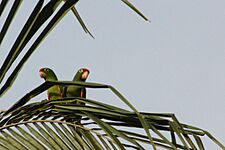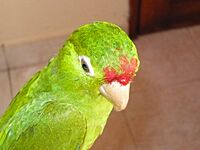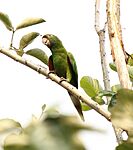Finsch's parakeet facts for kids
Quick facts for kids Finsch's parakeet |
|
|---|---|
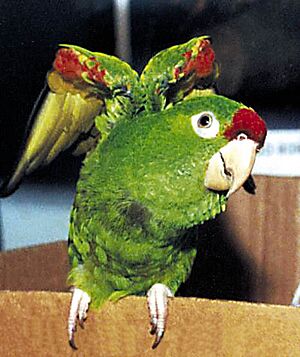 |
|
| Conservation status | |
| Scientific classification | |
| Genus: |
Psittacara
|
| Species: |
finschi
|
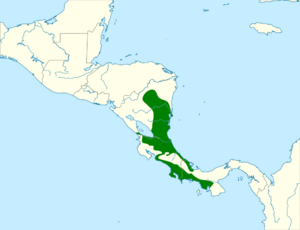 |
|
| Synonyms | |
|
Conurus finschi, Salvin, 1871 Aratinga finschi, Salvin, 1871 Aratinga leucophthalma finshi, Salvin, 1871 |
|
The Finsch's parakeet (Psittacara finschi) is a bright green bird. People also call it the crimson-fronted parakeet. In the pet bird world, it's known as Finsch's conure. This bird is a type of parrot. You can find it living in Costa Rica, Nicaragua, and Panama.
Contents
Understanding Finsch's Parakeet Groups
Scientists group animals together. This helps us understand how they are related. For a while, Finsch's parakeet was in a group called Aratinga. But around 2013, scientists moved it. Now, it belongs to the group Psittacara.
This parakeet was once thought to be a type of white-eyed parakeet. These two birds are very similar. Finsch's parakeet is a "monotypic" species. This means it doesn't have any different subspecies.
What Does Finsch's Parakeet Look Like?
Finsch's parakeet is about 28 cm (11 in) long. It weighs between 135 to 175 grams (4.8 to 6.2 oz). Male and female parakeets look the same.
Most of their body is green. Their belly feathers are a bit yellowish. They have a bright red forehead. You might also see some red spots on other parts of their head. The edges of their wings are red too. Sometimes this red looks a little orange.
The feathers under their wings are yellow. The underside of their flight feathers and tail are olive yellow. Their upper legs often have some red. Their eyes are orange. They have bare white skin around their eyes. Their beak is a horn color.
Young Finsch's parakeets look like the adults. But they have less or no red on their heads. They also don't have red on their legs. Their eyes are gray when they are young.
Where Finsch's Parakeet Lives
Finsch's parakeet lives in Central America. You can find them in southeastern Nicaragua. They also live on both sides of Costa Rica. This includes the Pacific and Caribbean coasts. Their range extends into Panama. They live on Panama's Pacific side, reaching the Azuero Peninsula.
These birds like many different places. They live in woodlands and at the edges of thick forests. They also like areas with new forests growing. You can see them on ranches and farms. They enjoy places with groups of trees, coffee farms, and even towns. They live from sea level up to 1,800 meters (5,900 ft) high.
Finsch's Parakeet Behavior
Finsch's parakeets are very social birds. They often fly in groups of about 30 birds. Sometimes, several hundred birds will gather to sleep together.
How Finsch's Parakeets Move Around
These parakeets travel quite a bit. They make irregular trips. They also move seasonally. These movements are not fully understood. During the dry season, more of them are seen on the Pacific side of Costa Rica.
What Finsch's Parakeets Eat
Finsch's parakeets eat many different things. They enjoy fruits and flowers from various plants and trees. They also eat maize (corn) and sorghum. Interestingly, they have been seen eating wood. This is not a common habit for parrots.
Reproduction and Life Cycle
Finsch's parakeets nest in Costa Rica. Their nesting season is from December to May. This is during the dry and early wet seasons. In Panama, they are thought to nest in July.
They build their nests in holes in trees. Sometimes, they even dig out these holes themselves in soft, rotten wood. They might nest in small groups. A female usually lays three to four eggs. We don't know how long the eggs take to hatch. We also don't know much about how long the young stay in the nest. Details about how the parents care for them are also unknown.
Finsch's Parakeet Sounds
Finsch's parakeets are very noisy birds. You can hear them especially when they are flying. They make a "jangling chattering" sound. It sounds like "klee-klee-chee-chee...". They also make sharp, squeaky notes. They have loud, harsh calls too. These calls sound like "scree-ah".
Status of Finsch's Parakeet
The IUCN (International Union for Conservation of Nature) checks on animals. They have listed Finsch's parakeet as "Least Concern." This means they are not worried about this bird becoming endangered.
The parakeet lives in a very large area. There are at least half a million adult birds. Their numbers seem to be steady. No major threats have been found for them. They are common in Nicaragua and Costa Rica. They are also common in some parts of Panama. Their habitat seems to be growing. This is because deforestation creates more open areas, which they prefer. People don't often capture them for the pet trade either.
Gallery
-
Pair in the wild on the Osa Peninsula, Costa Rica
-
Adult in San José, Costa Rica



